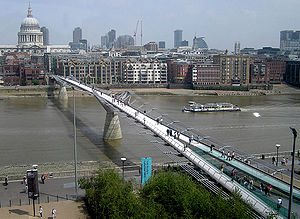Millennium Bridge
51°30′37″N 0°05′54″W / 51.510173°N 0.098438639°W
Millennium Bridge | |
|---|---|
 The bridge seen from a restaurant in the Tate Modern gallery. St. Paul's Cathedral is across the river. | |
| Coordinates | 51°30′37″N 0°05′54″W / 51.5102°N 0.0984°W |
| Carries | Pedestrians |
| Crosses | River Thames |
| Locale | London, England |
| Official name | London Millennium Footbridge |
| Maintained by | Bridge House Estates, City of London Corporation |
| Characteristics | |
| Design | Suspension Bridge |
| Total length | 370 metres (1,214 ft) |
| Width | 4 metres (13 ft) |
| Longest span | 144 metres (472 ft) |
| History | |
| Opened | 10 June 2000 |
| Location | |
 | |

The Millennium Bridge, also known as the London Millennium Footbridge, is a footbridge across the River Thames in London. It is a steel suspension bridge which links Bankside with the City. Its position is between Southwark Bridge (downstream) and Blackfriars Railway Bridge (upstream). The bridge opened on 10 June 2000. It is the newest bridge across the Thames.
Londoners nicknamed the bridge the Wobbly Bridge after people on a charity walk felt an uncomfortable swaying motion. The bridge was closed later that day. After two days of limited access the bridge was closed for almost two years. Expensive and complicated changes were made to eliminate the wobble. It was reopened in 2002.
The southern end of the bridge is near Globe Theatre, the Bankside Gallery and Tate Modern, the north end next to the City of London School below St Paul's Cathedral. The bridge is aligned so that a clear view of St Paul's south side can be seen from across the river, framed by the bridge supports.
Design
[change | change source]In 1996, the Southwark council organized a competition to design the bridge. The winning entry was by Arup, Foster and Partners and Sir Anthony Caro.
The eight suspension cables are tensioned to pull with a force of 2,000 tons against the piers set into each bank. The cables are strong enough to support a working load of up to 5,000 people on the bridge at the same time.
The bridge's closure only three days after opening attracted considerable public criticism. It was seen as another high-profile British millennium project that had suffered an embarrassing setback, similar to how many saw the Millennium Dome. There was some astonishment that engineers had not foreseen the problem, as computer modelling is such a standard technique today. However, modifications to the bridge did eliminate the wobble. The wobble has not reocurred since the bridge reopened in February 2002.
Resonance
[change | change source]
The bridge's movements were caused by a 'positive feedback' phenomenon. The natural sway motion of people walking caused small sideways oscillations in the bridge. In turn, this caused people on the bridge to sway in step, increasing the amplitude of the bridge oscillations and reinforced the effect.[1]
The bridge opened on an exceptionally fine day, and it was included on the route of a major charity walk. On the day of opening the bridge was crossed by 90,000 people, with up to 2,000 on the bridge at any one time.
The lateral vibration problems of the Millennium Bridge are very unusual, but not entirely unique.[2] Other bridges which have seen similar problems are:
- Birmingham NEC Link bridge, with a lateral frequency of 0.7 Hz
- Groves Suspension Bridge, Chester, in 1977 during the Jubilee River Regatta
- Auckland Harbour Road Bridge, with a lateral frequency of 0.67 Hz, during a 1975 demonstration[3]
After extensive analysis by the engineers,[4] the problem was fixed by fitting 37 dampers (energy dissipating) to control horizontal movement and 52 (inertial) dampers to control vertical movement. This took from May 2001 to January 2002 and cost £5M. After a period of testing, the bridge was successfully re-opened on 22 February 2002. The bridge has not been subject to significant vibration since. In spite of the successful fix of the problem, the affectionate 'wobbly bridge' epithet remains in common usage amongst Londoners.[5][6]
Related pages
[change | change source]References
[change | change source]- ↑ Strogatz, Steven et al. (2005). "Theoretical mechanics: Crowd synchrony on the Millennium Bridge," Nature, Vol. 438, pp. 43–44.
- ↑ Julavitz, Robert. "Point of Collapse," Archived 2008-06-17 at the Wayback Machine Village Voice. August 26, 2003.
- ↑ Dallard, P. et al. "The London Millennium Footbridge," Archived 2011-09-27 at the Wayback Machine Structural Engineer. November 20, 2001. 79:22, pp.17–35.
- ↑ "ARUP.com the millenium bridge". Archived from the original on 2011-11-02. Retrieved 2010-08-24.
- ↑ Urban75, London Landmarks
- ↑ "London Evening Standard, "Second wobbly bridge for London"". Archived from the original on 2009-10-30. Retrieved 2010-08-24.
Other websites
[change | change source]![]() Media related to London Millennium Bridge at Wikimedia Commons
Media related to London Millennium Bridge at Wikimedia Commons
